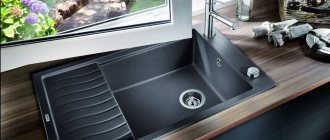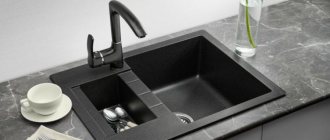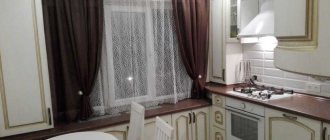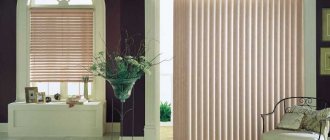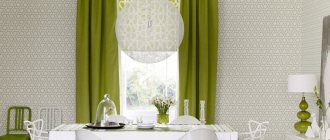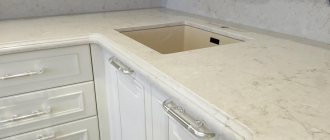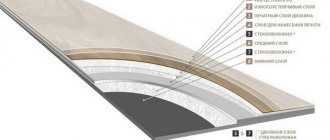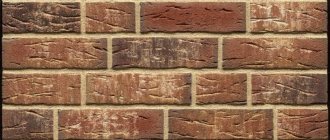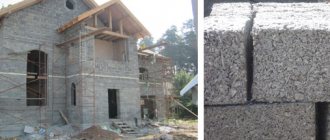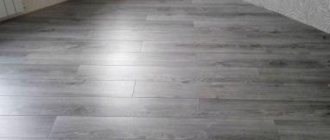Advantages of artificial stone
Purchasing a kitchen countertop made of artificial stone is a good solution for those who strive for not the most expensive, but attractive and durable furniture.
There is no doubt that countertops made of artificial stone have a higher price than wood, plastic or some other materials.
However, this disadvantage is compensated by a much longer service life guaranteed by the manufacturer. It can reach 15 years.
In addition, some types of artificial stone, from which kitchen countertops are made, can withstand restoration without compromising the quality of the coating.
An example is acrylic stone, scratches and other surface defects of which can be removed by grinding and then coated with a special compound.
Form
The size of the stone countertop for the kitchen should be selected slightly larger than the dimensions of the lower cabinets of the set. Holes for sinks, appliances and faucets are usually cut out at the manufacturing stage. Often the sink is integrated - made from the same artificial stone, without joints.
The shape of the tabletop is:
- classic rectangular;
- rounded;
- corner;
- asymmetrical.
Thanks to the plasticity of the raw materials and the ability to produce unusual shapes, the tabletop can extend onto the windowsill and be used to create a bar counter or dining area. Considering that the surface is seamless, it looks like a monolithic structure and provides the interior with sophistication.
Components of artificial compositions for countertops
- Synthetic resins as a binding component.
- Marble, granite chips and other natural materials.
- Fillers, plasticizers and pigments.
The world's leading scientific centers are developing new modern technologies that make it possible to produce materials with improved properties, including artificial stone for the kitchen.
Manufacturers of kitchen furniture are trying to keep up with the times, and the latest scientific developments are immediately introduced into mass production.
Complete information about the world leaders in the production of kitchen countertops can be obtained on the manufacturers’ specialized websites.
There you can also see numerous photos of countertops made of artificial stone, which will allow you to make an unmistakable choice.
Which artificial stone is best for countertops?
Depending on the material and production technology, the following types of artificial stone are distinguished.
Acrylic stone
The most popular and most affordable among other types. An acrylate tabletop contains 60-70% mineral content, which is why this option is cheaper than those listed below.
Acrylic stone is produced by mixing mineral components or natural stone chips with acrylic resins. The composition is glued to a base made of a sheet of moisture-resistant plywood, MDF or chipboard.
Production involves high temperatures of 150-200 degrees Celsius. This is why acrylic countertops have poor heat resistance, which means you cannot place hot dishes on them.
The average price for acrylate countertops in Russia starts from $120 per linear meter.
The greater the proportion of natural material in the composition, the more expensive the acrylic countertop will be. To reduce the cost of production, some manufacturers add components to the composite that only imitate natural stone. Premium segment countertops are made with the addition of a large proportion of real stone chips.
Aesthetic qualities are one of the factors of their popularity.
Even a plain white countertop made of artificial acrylic stone looks great due to its seamless surface.
The acrylic tabletop scratches easily, so it requires gentle care. In order to clean the table from dirt, it is enough to wipe it regularly with a soft cloth soaked in a soap solution.
Liquid stone
This material is often confused with the previous one. But a countertop made of liquid stone is distinguished by a different manufacturing technology. This is a method of covering surfaces, as a result of which the material acquires the operational characteristics necessary for the kitchen - impact resistance, resistance to high temperatures, moisture resistance.
Sheets of chipboard, MDF or plywood are wrapped on all sides with a plastic compound consisting of 80% tinted marble chips and a polyester binder. The result is a seemingly sealed package that does not allow moisture to pass through.
The average price for liquid stone in Russia is from $130 per linear meter.
The cost depends on the thickness of the facing layer (from 3 mm to several centimeters) and the base material (MDF, for example, is more expensive than chipboard).
Quartz agglomerate
A countertop made of compressed quartz chips is almost no different in composition from natural stone. After all, the product will contain about 90-95% of the natural component, the rest will be a polyester resin binder. Therefore, there will be the same disadvantages of the natural analogue - heavy weight, difficult transportation and installation, and the inability to create a seamless coating.
Advantages over natural stone - resistance to stains, super strength.
Real tests of the strength of the material can be seen in the following video:
This material is not afraid of even aggressive detergents, so it does not require special care.
The average price in Russia for sinter starts from $230 per linear meter.
All the possibilities, pros, cons and differences of all three types of artificial stone can be seen in the table below.
On a three-point scale* we will evaluate all three types of materials for making kitchen countertops.
* “3” is the highest score.
| Acrylic stone | Liquid stone | Quartz agglomerate | |
| Impact resistance, chip resistance | 2 | 3 | 3 |
| Scratch resistance | 1 | 3 | 3 |
| Heat resistance | 1 | 3 | 3 |
| Moisture resistance | 2* * The tabletop is not protected on the reverse side. The presence of a drip tray will prevent water from entering. | 3 | 3 |
| Color fastness to fading | 3 | 3 | 3 |
| Resistance to household cleaning chemicals | 2* Do not wash with abrasive agents; cleaning only with soapy water is allowed. | 3 | 3 |
| Weight, ease of installation | 3 | 3 | 2 |
| Possibility of restoration, repair of scratches, chips | 2* * Scratches can be sanded out. It will not be possible to restore areas with large chips unnoticed. | 3 | 0 |
| Possibility of creating a seamless coating | 3 | 3 | 1 |
| Affordable price | 3 | 2 | 1 |
Watch the video comparing agglomerate and acrylic:
Acrylic stone
It is most famous and widespread among buyers due to its lower price compared to other types of coatings.
Note!
U-shaped kitchen: pros and cons of the U-shaped layout. Methods of arranging furniture, dividing into working and dining areas. Photos and videos of design ideas- Kitchen facades: TOP 180 photos and video reviews of kitchen facades. Types of frames, criteria for choosing materials and color solutions
- Short curtains for the kitchen - features of using short curtains in small and large kitchens. Advantages and disadvantages of fabric materials (photo + video)
The mineral component makes up only up to 70% of its volume, which makes production cheaper and more economical compared to competitors.
In addition to natural stone chips, the composition includes acrylic resins as a binder. The resulting mixture is applied to sheet plywood, chipboard or MDF panels.
During the manufacturing process, acrylic stone is exposed to temperatures of 150-200°C.
For this reason, this material has reduced resistance to elevated temperatures, which leads to the possibility of damage to the surface from placing hot cookware on it.
Natural stone countertops
A special feature of products made from monolithic rocks is a unique pattern created in natural conditions. There are no two identical countertops made of natural stone in the world. These products are reliable and durable.
Advantages compared to an artificial analogue:
- long service life - at least 13-17 years;
- heat resistance;
- possibility of multiple restoration.
However, natural stone also has disadvantages that agglomerate and acrylic do not have:
- heavy weight (a durable base cabinet in the headset is required);
- installation and cutting is carried out only by professionals;
- high price;
- cold surface.
Price
The cost of acrylic stone countertops in Russia starts from $120 per meter. The cost of producing a coating increases with the number of natural components in its composition.
Note!
- Water filter for the kitchen: functions and benefits of a water filter in the kitchen. Types of filters and mechanisms, their pros and cons (photo + video)
Kitchen in high-tech style: 135 photos and video master class on organizing space and design
Kitchen in modern style - 160 photos of the best design options and features of the style
To reduce these costs, natural stone simulators are added to the initial mixture. The composition of the highest class countertops includes mainly natural stone chips.
Price
On the domestic market, the average cost of liquid stone is $130 per meter.
The price is affected by the quality of the base (for example, chipboard is cheaper than MDF panels), and the thickness of the cladding layer, which can range from a few millimeters to several centimeters.
Characteristics
An artificial tabletop has its own technical characteristics. For quartz and acrylic they are different, which is reflected in the cost, the first is more expensive, the second is cheaper.
Strength and Durability
Countertops made of decorative stone are the most durable among competitors made from other materials, except for metal models and some types of natural stone. Their service life is estimated in decades, and their relatively low cost makes them affordable. Compared to their counterparts made from MDF and laminated chipboard, they can easily withstand heavy loads.
Quartz samples are not afraid of high temperatures. According to the manufacturers, they can withstand 180-degree heat. They are scratched, but restoration leads to the original appearance. This applies to acrylic models that cannot withstand high temperatures. They can be easily removed from scratches, even if they are deep.
Nice appearance
Kitchen countertops made of artificial stone imitate natural material. Granite and marble are popular. Many colors and shades allow you to create harmony in the kitchen interior and decorate the room. Flat and embossed slabs are available for sale.
Environmental friendliness
The countertops are non-toxic and do not emit harmful substances when exposed to temperature. Ideal for the kitchen, you can cook with them without fear for your health. Accordingly, not directly on them, but on cutting boards, otherwise you will completely damage the glossy surface of the acrylic plates.
Quartz agglomerate
The material of such a countertop coating made of quartz chips differs little from natural stone. It contains up to 95% natural quartz, and polyester resin acts as a binder.
This is associated with the same disadvantages inherent in natural materials - the lack of seamless coating technology, increased weight and difficulty in delivery.
Agglomerate (quartzite)
The agglomerate contains:
- quartz chips;
- pigments that give different colors to the material;
- polyester resin.
The proportion of quartz chips is at least 90%. Thus, the material consists almost entirely of durable natural stone. It is produced using vacuum pressing at high temperature. The finished slab is hardened and polished.
It is countertops made of this material that have all the advantages of artificial stone. A kitchen countertop made of quartz sand cannot be cut ; it can withstand high temperatures without problems; a hot frying pan or kettle can be placed directly on it without fear. Of course, it also has its main drawback - its high price. Quartzite countertops are the most expensive.
Another disadvantage of agglomerate is that its parts cannot be glued into a single whole; they can only be laid end-to-end. Long countertops are not produced entirely - there are technological limitations, difficulties in transportation and installation, and besides, it will simply be impossible to carry a large slab of an unusual shape into the apartment.
Let us summarize the advantages and disadvantages of countertops made of artificial stone based on quartz.
Advantages:
- cannot be cut or scratched;
- resistant to high temperatures;
- easy to clean;
- resistant to food dyes;
- hygienic and environmentally friendly;
- wide range of colors.
Flaws:
- high price;
- only standard slab shapes;
- joints between panels;
- Chips and cracks can only be repaired by a specialist.
Positive qualities of quartz agglomerate
This material has significant advantages over its natural counterpart - increased strength, resistance to aggressive chemical influences and pollution.
Highly active detergents do not have a destructive effect on this material.
What are the disadvantages of artificial stone?
This material has one significant drawback - high price . The cheapest countertop will cost at least 7,000 rubles per linear meter. On the market you can also find offers with a much higher price.
Due to the strength of the material, it is impossible to adjust or change the shape of the tabletop with your own hands . Even if you can cut the slab with the help of a grinder and a lot of patience, you won’t be able to properly process and sand the edge at home.
There are two types of artificial stone and they differ in composition.
Advantages and disadvantages of the materials considered
All materials are resistant to fading, easy to install, and lightweight, with the exception of quartz agglomerate.
Liquid stone and quartz agglomerate are heat-resistant and not susceptible to the destructive effects of cleaning agents, scratches, or moisture.
Acrylic stone has the lowest price, allows restoration and the possibility of seamless coating.
At the same time, this material is not sufficiently resistant to moisture, has low thermal stability, and has low scratch resistance.
Pros and cons of natural stone
Kitchen countertops made of natural stone have one distinctive feature - a unique pattern created by nature itself. Their main advantages are durability, immunity to mechanical damage, and wear.
Despite its high cost, natural stone is popular. This is due to its excellent decorative qualities.
In most cases, the base for countertops is marble or granite, less often - onyx, quartz or gabbro. The color of the product may also differ - from greenish-gray to gray-brown, from reddish-brown to purple, pink or scarlet. The shade of the material depends on the place where the stone was mined.
Marble
Marble is a natural stone that was formed by silt deposits in sedimentary rocks. The chemical composition of marble is calcium carbonate. These natural stone countertops for the kitchen have a cool surface with an exquisite pattern. Their color is given by inclusions of salts of various metals, mineral clays and silicon.
The combination of salts of various metals, mineral clays and silicon provides the surface with an intricate pattern
The price of this material depends on the color. Cheap varieties are white and yellowish, more expensive are pink and gray shades, the most expensive are black and burgundy with veins.
Minor scratches on the surface can be removed by polishing them
Advantages : A kitchen countertop made of natural stone, or rather marble, has an incredibly beautiful appearance and a unique pattern. With proper care it can last for decades. Resistant to minor scratches, which can be removed by polishing.
Disadvantages : Stone kitchen countertops made of marble have a porous structure, due to which various coloring liquids (from wine or coffee) can leave noticeable stains on it. Traces from hot dishes remain on it, and marble easily deteriorates from exposure to any acid-based product. Also, we must not forget about the high price of this material.
Kitchen counters with marble stone tops are easily stained by wine, juice or other colored liquids.
Granite
Granite is one of the hardest and most wear-resistant natural stones. It is distinguished by a variety of colors and mirror shine. For example, an elegant black stone countertop for the kitchen will fit perfectly into a classic or modern interior.
Granite has a wide range of colors and elegant shine
Advantages : Granite is moisture resistant, tolerates high temperatures, and is resistant to minor scratches and damage. The material is also resistant to acids and has a long service life.
Disadvantages : Kitchen countertops made of granite stone have at least one serious drawback - absolute inability to repair in case of mechanical damage. In other words, if you were strong enough to break such a surface, then it will have to be replaced with a new one. In addition, granite slabs cannot be joined using a seamless method.
If damaged, the granite coating will have to be completely replaced.
Validity of choice
Deciding on a new kitchen design style with artificial stone countertops will require significant financial investment and sufficient justification.
To minimize the risk, you should read user reviews about certain models and technologies, and only after receiving the necessary information make a final decision.
Peculiarities
A stone countertop is a sought-after and prestigious type of finishing for a kitchen work surface. It looks respectable and serves for decades; it is appropriate in country, high-tech, classic, and Provence styles.
A countertop made of artificial stone looks almost no different from the original, but is more affordable. At the same time, it costs much more than economy-class products: laminated chipboard or MDF.
The material is made from polymers, stone chips, resins, pigments and adhesives. This countertop is environmentally friendly, hygienic, and is not afraid of temperature changes and high humidity.
Compared to natural stone, it has the following advantages:
- a light weight;
- hygroscopicity (no pores, does not absorb moisture, does not form indelible stains);
- possibility of grinding and repair;
- variety of shapes and colors.
Natural stone outperforms artificial stone in aesthetics—factory-made countertops do not have a unique pattern.
